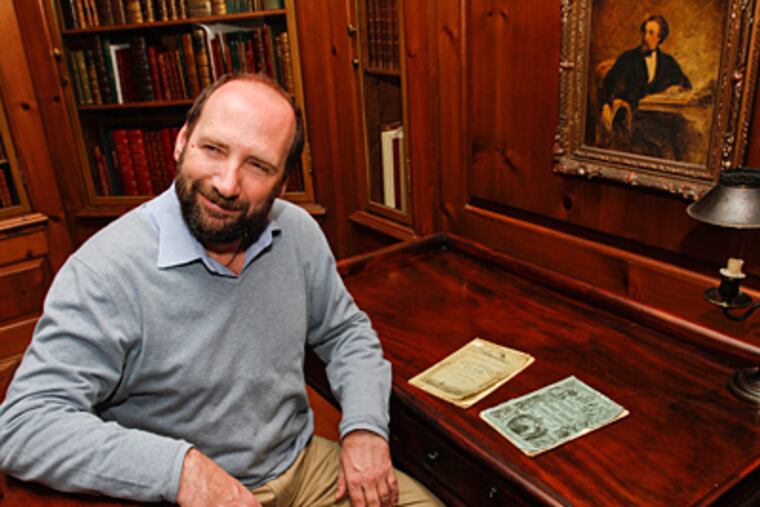Dickens kin gets an early Christmas present
Marley was dead: to begin with. There is no doubt whatever about that. The register of his burial was signed by the clergyman, the clerk, the undertaker, and the chief mourner. Scrooge signed it. And Scrooge's name was good upon 'Change, for anything he chose to put his hand to.

Marley was dead: to begin with. There is no doubt whatever about that. The register of his burial was signed by the clergyman, the clerk, the undertaker, and the chief mourner. Scrooge signed it. And Scrooge's name was good upon 'Change, for anything he chose to put his hand to.
Old Marley was as dead as a doornail.
So begins Charles Dickens' most famous tale, A Christmas Carol, first published in 1843 and republished in innumerable editions and languages ever since.
The story has been made into movies, plays, puppet shows, operas, and radio dramas. It has been mimed by Marcel Marceau. Composer Benjamin Britten based a chamber piece on it.
And since 1993, Dickens' great-great-grandson, the actor Gerald Dickens, has performed this family relic as a one-man show all over Britain and the United States.
On Friday, the living Dickens visited the Central Library of the Free Library of Philadelphia to take in the first exhibitions mounted by the library in celebration of the 2012 bicentennial of the novelist's birth.
"What a superb collection of Dickens memorabilia and original works and letters!" Gerald Dickens exclaimed. "I've learned so much. It's very easy when I travel around talking about Charles Dickens to speak of him as this great historical character. But seeing this collection really brings him to life. Here is my grandfather!"
Gerald Dickens, 48, makes his home in Oxford, England. But he comes to the United States often, particularly during the holiday season to perform his solo Christmas Carol, complete with all 26 characters.
On Saturday he will perform in Chalfont, and then it's on to Hershey, Burlington, and Bryn Athyn. (For a schedule, visit www.byerschoice.com.)
That Gerald Dickens, bearded and affable, should be wowed by the Free Library exhibitions should not be surprising. The library, thanks to huge donations of materials from William M. Elkins and D. Jacques Benoliel, has one of the most extensive Dickens collections in the world.
On view now are two separate displays. One, on the first floor, consists of illustrations inspired by Dickens' countless fictional characters, from "Boz" (actually Dickens himself) through Little Nell and on to Edwin Drood.
In the rare-book department on the third floor is an extensive exhibition that hints at the richness of the library's holdings. Here are letters, first editions, and innumerable objects, including a stuffed raven, Grip, a Dickens pet who appears in the 1841 novel Barnaby Rudge. (Poe scholars believe Barnaby Rudge's feathery Grip inspired Edgar Allan Poe, although they quoth no evidence for the claim.)
Gerald Dickens was particularly excited by the Elkins Room at the end of the exhibition, where his great-great-grandfather's mahogany writing desk sits quietly.
Above it is a portrait of Charles Dickens and a famous oil sketch by Sir Luke Fildes, The Empty Chair. It shows the desk in front of a window looking out on the Dickens garden in Gad's Hill. It was painted days after the novelist's death in 1870 at age 58.
A lamp on the desk is in the painting. A postal scale, displayed in another part of the exhibition, is also in the painting.
"It's so colorful," Gerald Dickens said, peering at the scene with its Turkish rug and garden flowers.
Janine Pollock, head of the rare-book department, pulled out a handy flashlight and shined the light on the desk surface.
"It's carved," she said.
"Oh, yeah!" said Gerald Dickens, looking down at the clearly visible CD.
"This," he said, "is a serious piece of furniture."
Why, he was asked, is A Christmas Carol such a popular work? After all, it is a novella and, in literary terms, it is far from Dickens' achievements in such novels as Great Expectations, Bleak House, and Our Mutual Friend.
"The story is so simple, so perfect, that you can't go wrong with it," he said. Bad behavior, defined as greed and inhumanity, is shown its own dreary future, exposed by innocence and simple charity.
Social themes like this are the essence of Dickens, his great-great-grandson said.
"It was so important to him to narrow the gap between rich and poor, something we're still struggling with today," said Gerald Dickens. "He did this by highlighting terrible conditions, and he got the job done not by lecturing or beating people over the head, but by being entertaining."